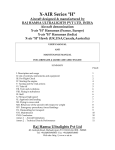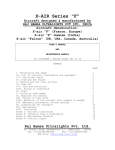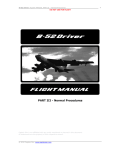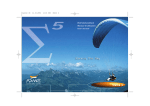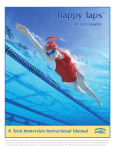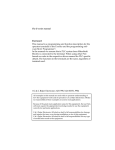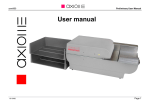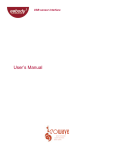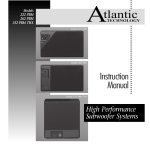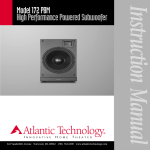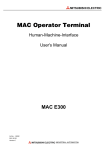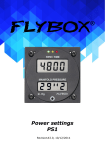Download user`s manual - Raj Hamsa Ultralight
Transcript
X-AIR Series "F" Aircraft designed & manufactured by: RAJ HAMSA ULTRALIGHTS PVT LTD, INDIA Aircraft denomination: X-air "F" (France, Europe) X-air "F" Gumnam (India) X-air "Falcon" (UK,USA,Canada,Australia) USER'S MANUAL AND MAINTENANCE MANUAL For AIRFRAME & ENGINE JABIRU 2200 SUMMARY PAGE I. Description and usage II. List of controls, instruments and equipment III. Pre-Flight Check IV. Starting the engine V. Taxiing and the vital actions VI. Take off VII. Turn and evolutions VIII. Flying in turbulence IX. Stall X. Flying at high speed XI. Approach and landing XII. Flying in cross wind XIII. Behaviour of the aircraft with respect to weight XIV. Emergency procedures, forced landings XV. Dismantling for transport XVI. Maintenance XVII. Conclusion Annex 1 : Aircraft limitations Annex 2 : Technical Data & Performance Annex 3 : Maintenance Schedule Annex 4 : Controls layout Raj Hamsa Ultralights Pvt Ltd 40, Goshala Road, Mahadevpura P.O. BANGALORE - 560048 Tel: +91(0)80-56965835 Fax: +91(0)80-8518485 Web site: http://x-air.in 1 1 3 4 5 5 6 7 7 7 8 8 9 9 10 11 12 13 13 16 19 1 RAJ HAMSA ULTRALIGHTS PRIVATE LIMITED X-AIR Series "F" USER'S MANUAL AND MAINTENANCE MANUAL (revised January 2012) I. DESCRIPTION & USAGE: GUMNAM is a fixed wing ultralight aircraft, two-seater side by side, front engine mounted, high wing, tricycle undercarriage, fitted with conventional 3-axis controls: ailerons, elevator and rudder. In its standard version equipped with complete dual controls, GUMNAM can be used for recreational flying as well as for instruction: the excellent behaviour of this aircraft in terms of responsiveness, docility, forgiveness slow landing speed, make it idealy suitable for this activity. GUMNAM is an inexpensive aircraft in terms of capital investment and cost of operation: However the controls layout and the feeling in flight are even more similar to those of a light aircraft (example: Cessna 152) than its predecessor, our X-AIR, from which it has evolved: GUMNAM, sporting a smaller wing area, a better streamlined fuselage and very effective FLAPS, although it fits by all criteria in the MICROLIGHT CATEGORY, has nothing to envy from a regular aeroplane and as such offers an undisputed alternative for imparting flight training within the constraint of limited budgets. GUMNAM is fitted in option with the JABIRU 2200 4-STROKE engine: the outstanding rate of climb at take off with 10 degrees of flaps brings an added safety in routine circuits and there will be that comfortable feeling of always having extra power at one's finger tips, if required. II. LIST OF CONTROLS, INSTRUMENTS & EQUIPMENT: 1. Controls: - Control stick 2 Nos : controls elevator (pitch) and ailerons (roll) - Rudder pedals (2 pairs) : controls rudder (yaw) and nose wheel steering - Throttle lever 2 Nos, left hand, controls power (push for power) - Toe brakes: differential, on left hand side rudder pedals only, control 1 brake on each main undercarriage wheel 2 - Trim handle: between pilot and passenger, controls elevator trim (forward: aircraft nose down) - Flaps control lever: on cabin ceiling (lever down: flaps down) - Two engine ignition switches (dual electronic ignition, toggle up: on) - Master switch (key operated, turn clockwise: on) - Self starter switch (press to start) - fuel pump switch (toggle up: on) - Choke lever (lever up: choke open) Please note that all the controls are strictly conventional: Effects of controls Action on controls Effect obtained Press right foot Press left foot Stick to the right Stick to the left Stick forward Stick back Throttle forward Throttle back aircraft yaws to the right aircraft yaws to the left aircraft banks to the right aircraft banks to the left aircraft nosedown aircraft nose up increase power reduce power 2. Instruments (Standard): - ASI (air speed indicator) - Altimeter - Ball - Compas - Tachometer (RPM) - CHT, oil temperature - Charge indicator Options: Intercom, EGT and other engine monitoring instruments, GPS, etc.. 3. Fuel tanks: - Standard capacity, 55 liters in 2 FRP tanks located behind seats - Drain on each - Breather on each - Tank transparency ensures visual fuel level check. 4. Other features: - cockpit doors, luggage boot behind seats and wheel pants are standard. III. PRE-FLIGHT CHECK: 3 A good pre-flight is the foundation of safe flying. We suggest that you go through the following checks before each flight session. 1.Engine: Stand in front of the engine and check: - the propeller and its bolts - the reduction gear: no oil leak - the engine supporting frame (ensure that the rubber foundations are in good condition) - the cooling system: radiator full of coolant and no leaks in the hose connections; radiator rubber mountings in good conditions. - aspect of the ignition units and adjoining leads. - spark plug caps properly fitted. - the exhaust fittings and the exhaust rubber foundations. - no cracks developing in the exhaust - throttle and choke cables for fray or misadjustment. - carburetors and air filters properly secured. An aircraft engine should always be spotless clean! 2.Airframe: Start from left looking at the aircraft from front and check the following attachments: - top of the front fuselage tube - base of the same tube plus check the bolts at the main axle assembly - the wing struts at the stainless steel tangs and pins/safety rings. - check the right wing: - the sail condition at the leading edge - the wing tip tube fully secured - the sail condition at the trailing edge - battens properly positioned - the wing struts from bottom tang to wing tang - the compression struts at both ends - the jury struts - the root attachements of the trailing edge and leading edge - check ailerons attachments and safety rings - check flaps attachements - check ailerons cables, fittings, turnbuckles and pulleys - follow the fuselage up to the tail and check the following attachments : - the elevator hinges - the elevator struts on top and bottom - the elevator control plates - the elevator leading edge connection to the keel - the upper part of the rudder & its general aspect - the lower part of the rudder - the rudder cables connection with the rudder plates - the trim tab connections - look into the cockpit and check: 4 - the sticks and corresponding pulleys/cables - the rudder cables condition especially between the seats and make sure that they are crossed in the fuselage (ref. annex 4) - the ailerons "friction free" control cables assembly - the throttle cable and choke cable connections in the cockpit are free-moving and exempt of fray or damage - the fuel tanks air breather are free, fuel cap is closed and the content is sufficient for the flight - the fuel filter condition - the fuel line connections - check the left wing: - the wing struts stainless steel tangs at the axle - the wing struts till the upper tangs on the wing - the compression struts at both ends (open velcro flap) - the jury struts (and remove the ASI venturi cover) - the battens properly positioned and the look of the sail - the wing tip secure - check: - the base of the front fuselage tube & attachement at the engine frame. You are back at the nose: your tour is complete and you may now fly with peace of mind. 3. Instruments: - verify ASI functioning and set altimeter - verify the proper functionning of all installed instruments - before take-off for a cross-country flight the reading of the compass must be checked against a known reference: runway markings for example. IV. STARTING THE ENGINE (Jabiru): If you respect the following procedure, you will avoid problems while starting your engine: a. Cold engine: 1. Check throttle closed 2. Prime the carburetors by mean of electric pump 3. Keep ignition off and choke open 4. Press starter button & rotate the propeller for a few seconds 5. Choke full closed (down). Throttle closed 6. Switch both ignitions on 7. Check for CLEAR PROP ! 8. Press the self starter button; the engine should start at once 9. As soon as started open throttle up to 1300 RPM and reduce progressively the choke till full open 10. Warm up the engine for 3 minutes at 1300 RPM. !! WARNING !! Never forget to open the choke, failing which your power will be drastically affected in flight. 5 Never forget to switch off the electric pump:a pump permanently on increases fuel consumption by 30 %! This pump is a primer or else a back-up to be used only in the 2 following cases: 1. emergencies due to engine misbehaviour related to fuel starvation whatever the cause 2. as a preventive mesure in case of marginal take off in hostile surroundings, for a brief duration, say 1 minute. b. Warm engine: throttle idle position, pressing the starter is sufficient to restart. V. TAXIING & THE VITAL ACTIONS : Before anything, you should have investigated your aircraft limitations! Please refer to annex 1. You are now sitting on board, you have tightened your shoulder harness. The front wheel control is coupled with the rudder. Push the left pedal to turn left, the right pedal to turn right. On rough surface we recommend to taxi faster with front wheel up. Steering control with the rudder becomes efficient from 15 Km/h onwards. At the end of the taxiway, and before take off... you are invited to perform the vital actions : 1. open doors and VISUALLY check for free and correct directional movement of all control surfaces. 2. doors locked. 3. no obstructions/loose objects in the cockpit which could interfer with the controls. 4. mag check: maximum drop permitted = 300 rpm. In normal conditions both mags should be ON while flying. 5. instruments check 6. choke closed 7. fuel quantity check: do NOT take off with less than 10 liters in the tank. 8. flaps lowered in take-off position, first notch, 10 degrees 8. no aircraft in approach. 9. line up. Everything in order, you may take off. VI. TAKE OFF: !! WARNING !! PILOT QUALIFICATION It is clear that the following advices are not a flying course and that you are supposed to have passed with success the theoretical and practical tests under an authorised Instructor as required in your Country. Furthermore we wish to warn conventional aeroplane pilots that a few hours of conversion to the type is necessary before flying 6 solo. The particular behaviour of a microlight — related to its comparatively low wing loading — demands a bit of acclimatation. Well, The breeze is gentle. The aircraft is lined up. Push progressively the throttle to full open and gradually release the pressure on the front wheel. At 50 Km/h IAS, pull back progressively on the stick, maintaining your heading by foot control. At 55 Km/h indicated you are rotating; ease the stick forward to level off and increase your speed, then climb at 70 Km/h up to 100 meters (300 ft) full throttle: the rate of climb is about 3 meters per second with passenger. Note: The normal engine RPMs in the take-off run should be in the range of 3000 to 3300 In the event of your engine not reaching at least 3000 rpm at full throttle YOU MUST ABORT TAKEOFF and investigate the cause of lack of power. When you reach the altitude of 100 meters, retract the flaps, reduce throttle keeping at 60 Km/h airspeed and climb gradually up to the safe altitude of 300 m AGL (1000 ft). At this altitude you may level off, reducing throttle to 2800 rpm, and maintaining an economy cruise speed of 90-100 Km/h IAS. This air speed is also the best handling speed and should be given preference in turbulent air. Note: Please keep in mind that you are using a NON-CERTIFIED ENGINE; therefore, tree top height circuits are not recommended. 200 m (600 ft) is just fine. In the case of loss of power, or worst, of engine failure during take off, push immediately the stick forward to maintain maneuvrable speed and try to land ahead. Avoid steep banks which will increase your loss of altitude. Do not fiddle with the engine but concentrate on your landing, face the wind and keep constantly an eye on your ASI. It will help you to relax if you remember that GUMNAM glides very well engine off and remains perfectly maneuvrable. For safety, do maintain an air speed of at least 80 Km/h. If they have already been retracted, Do not forget to lower the flaps to 2nd notch (25°) in final, which is a primordial consideration for short landing. However it is good to keep in mind that your engine reliability will be fairly high if you scrupulously observe the maintenance schedule given by the manufacturer: please refer to annex 3. VII. TURNS & EVOLUTIONS: - GUMNAM responds neatly to any stick input in roll. - Be very gentle with the stick: the effect is immediate. - Keep the banked attitude as long as you need; then simply come back to neutral coordinating the maneuver with your feet. - To begin with, limit yourself to a gentle bank of not more than 10° to the horizon. Watch the ball and seek for perfection. 7 - Never forget that while banking the stall speed of the aircraft increases with the angle. From a mere 50 Km/h in horizontal flight, it shoots up to 70 Km/h in a 60° bank! - You will quickly enjoy the superb maneuvrability of GUMNAM but never forget that, in spite of the fact that the aircraft may eventually endure the loads applied while executing drastic maneuvres, it has not been designed in view of performing aerobatics and furthermore: aerobatic maneuvers are forbidden with an ultralight aircraft VIII. FLYING IN TURBULENCE: Thanks to the dihedral, the sweep-back and the washout induced in the wing design, GUMNAM is self-stable and when disturbed from its course will return to a normal attitude on its own: therefore it is important for the pilot to understand that tension is not necessary; just let the aircraft fly and do the least possible corrections. In strong wind conditions, never forget the gradient effect which may induce unexpected stalls at low altitude while landing — particularly in the last turn: misjudment of gradient is a too frequent cause of accident in light aircraft, so beware... avoid steep banks and at low height, do fly at 70 Km/h or more. IX. STALL: To understand perfectly the flight envelope of your machine, you must perform a few stalls. To do so, climb at 1000 ft AGL and begin with stalls, engine idle. At about 50 Km/h the aircraft (clean) becomes less responsive. If you pull the stick further backwards, the aircraft will execute a gentle stall break. Open throttle and push stick forward, the aircraft will recover with less than 20m altitude loss. At full power, the high nose attitude will be more impressive and the break rougher: the maximum altitude loss will be 30 meters in a fully loaded two seater.An assymmetrical stall generates a larger loss of altitude: recovery comes with stick forward followed by opposite aileron. By design, GUMNAM is extremely reluctant to enter into spin. X. FLYING AT HIGH SPEED : Beyond 100 Km/h IAS the back pressure on the stick due to the longitudinal self stability will force you to maintain a forward pressure on the stick to maintain level flight or to make use of the elevator trim in order to cancel the nose-up tendency (please note that the trim is capable of taking care of all the longitudinal situations in the flight enveloppe). However high speeds are not fuel efficient and submit your engine to unnecessary stress. Do avoid them. 8 XI. APPROACH & LANDING: To begin the descent, reduce throttle and set 70 to 80 Km/h indicated air speed in the final: Remember that you adjust the speed with the stick and the approach angle with the throttle. If the aircraft tends to overshoot, reduce throttle and vice versa if you undershoot, but in both cases do maintain your airspeed constant. It is airspeed which will give you protection against turbulence and gradient while landing. Maintain a safe altitude before the threshold of the runway, then come-in, with flaps down second notch (25°), throttle reduced at 1500 RPM (no less to keep a clean airflow on the tail surfaces) and execute a neat rounding-off avoiding fiddling with ailerons but rather using rudder if you have to correct the course at the last moment. This method is the safest for landing on unprepared fields. A speed reserve will allow you to keep clear of non visible obstacles such as fences, wires, big rocks etc.. and it will also be your guarantee against turbulence and wind gradient. A shallow angle, powered approach should be used only for landing on full fledge aerodromes with a clear and safe approach. After touch-down, maintain your stick up till your front wheel naturally touches the ground. This is a way to protect your front wheel from hitting roughly a stone or a clod of earth. In case of a small field with obstructions, a side-slip may come handy: GUMNAM is perfectly fit for this maneuver, at the condition again that you watch your airspeed: 70 km/h and no less. ADVICE: If you feel that your final is a mess, don't hesitate to overshoot and start a fresh circuit. XII. FLYING IN CROSS WIND: Don't fly in cross winds in excess of 20 Km/h unless you have a good experience of your aircraft. Take off is not a problem: just keep a bit of stick into the wind. While landing, do a crabwise final and first touch the ground with the wheel in the wind, then rectify your heading putting the second wheel on the ground. Keep nose wheel up and steer with rudder for as long as possible, till your speed has dropped so much that the wheel will drop on its own. Taxi with stick towards the wind. In any event, relax, since GUMNAM's behaviour in cross wind is examplary and in many cases, thanks to the short rolling distance required , you will be able to take- off and land headwind, eventually across a runway... Also, stronger the wind, shorter the rolling distance. IMPORTANT ADVICE: Never forget that an ultralight aircraft due to its very concept has a lower engine reliability than a certified aircraft and may be submitted to unexpected engine failure. 9 Therefore, maintain sufficient altitude to have the choice of a safe emergency landing field. Never fly over a congested area particularly over city or hills. or a hostile area at a low height, Make it a rule to be always within gliding distance of a safe field, as it was customary in the old days of Aviation. XIII. BEHAVIOUR OF THE AIRCRAFT WITH RESPECT TO WEIGHT: By the very concept of the aircraft, it is impossible to locate any load out of the C.G range and which cannot be taken care of by the trim. However, there is a slight tendency towards tail-heaviness increasing with load to be aware of, although the C.G. remains always well within limits. (Refer to the Weight and Balance Schedule of your aircraft). The elevator trim (a standard feature) is there to take care of these small variations and allow you to fly hands-off at any load and speed (within the respective permitted ranges: refer to aircraft limitations, annex 1.) Of course it is clearly understood that: 1. The luggage boot behind the seats has not been conceived to carry gold bars! 20 kg max please.. 2. The volume of fuselage behind the boot and the fuel tanks is NOT a cargo bay! The cockpit rear partition is there to remind everyone that NOTHING should be stored behind, a further complication being the possible interference with the control push-pull rods and cables. When flown at lower weights, solo for example, be prepared for a short take off and steep rate of climb; while landing you should avoid any abrupt flare to prevent the aircraft from ballooning (remember that an important characteristic of a microlight is its low wing loading) XIV. EMERGENCY PROCEDURES & FORCED LANDINGS: a. Emergency Procedures: Before attempting a forced landing: - Stay cool, relax, there is nothing to fear, it's NORMAL - Pick the largest field available, aligned with the wind - Fasten seat belts full tight (except over water) - Lower the flaps 2 notches (25°) - Switch both ignitions OFF - More important than anything else, WATCH YOUR AIRSPEED & LAND INTO WIND - After touch down keep nose wheel up if you can avoid braking immediately - If the field is ploughed, do land along the furrows b. On Corns and Crops: Bring the aircraft in final at the lowest possible speed and stall when your wheels are almost to touch the corns or crops. 10 This will protect you from a violent braking effect due to whatever the plantation. c. On Water: Altitude over water is difficult to judge! - Release your safety belt. - Face the wind - Make a mental preparation for your landing and try to figure out the best direction to swim away. Touch the water as slow as you can, slightly nose up. - Once in the water, don't panic, leave the aircraft without haste and don't try to take anything with you. d. In the Trees: If possible, select preferably low and dense trees, fasten your safety belt full tight. Keep good speed in final: the air is often turbulent on trees. As soon as you hear the first leaves brushing your wheels, pull the nose up full stick back to cut the speed and... good luck ! XV. DISMANTLING FOR LAND TRANSPORT: We suggest to operate on grass or a soft surface to avoid damaging tubes or spoiling the sail. A. Dismantling: The rudder and the tail plane will remain in place or the horizontal surfaces may be folded upwards; in any case, the mobile surfaces will be held with bungees to prevent shaking during transport. Removal of the wings: 1. Remove upper and lower root covers as well as the 8 straps connecting the 2 wings 2. Remove lower surface battens. 3. Remove upper surface battens, proceeding from tip to center. 4. Disconnect the ailerons control cables. 5. Disconnect the jury struts on top only. 6. Have a helper holding the wing level at the tip, remove the pins from the wing struts and take the struts away. 7. Disconnect the pins connecting leading-edge to keel as well as trailing edge to keel and take away the wing. Keep all pins at respective places on struts and brackets. 8. Proceed identically with the other wing. 9. To disassemble the wing further, you may separate the aileron and disconnect the two compression bars on the trailing edge as well as the cable on the trailing edge. Extract gently the sail from the structure and fold it carefully. 10. All components in aluminium should be handled with care and wrapped in plastic or cloth for transport. Salient fittings should be further protected with foam. NOTE: It is a well known fact that careless transportation generates more wear and tear than lots of flying hours. 11 B. Reassembling: Follow exactly the same procedure in the reverse: Enter the structure of the wing in the sail, connect the wing to the keel, assemble wing struts and jury struts, reconnect ailerons and ailerons control cables enter all battens from root to tip, reconnect both wings with belts, cover the root, and proceed with a careful and complete preflight check as described in para III. XVI. MAINTENANCE: We cannot insist enough on the importance of the maintenance of your aircraft: only a strict maintenance discipline applied to both engine and airframe will give you peace of mind in flight... In addition to the daily inspection schedule (Preflight Check para III), you will find in annex 3 a comprehensive maintenance schedule for both engine and airframe; this schedule is based on our long standing experience of flying under tropical conditions: observing scrupulously this shedule will give you the best possible garantie of trouble-free operation. You may also refer to the ROTAX engine manual for more details specific to your engine. It is also important that you maintain an up to date AIRCRAFT MAINTENANCE LOG BOOK where you will record any problem, work, modification, etc.. related to your aircraft: This is a mandatory DGCA requirement. You will have to comply with the maintenance schedule of annex 3, then sign & date the sheets in the bottom box after having executed and ticked the respective operations. ! ATTENTION ! At the time of renewal of your PERMIT TO FLY you will have to provide an up to date Journey Log Book and an up to date Maintenance Log Book along with the duly filled Maintenance Shedule sheets (ann.3) The in-between 100 hours operations of maintenance are very simple, and anybody with a sense of cleanliness and method can do it. On the other hand: We recommand that you send your engine to us EVERY 1000 HOURS FOR OVERHAUL We have the expertise for decarbonising and overhaul and it is easy enough for you to remove the engine and crate it to us: the work will be done quickly and safely at a reasonnable fee. To make our task easier, we request you to send your Maintenance Log Book along with the engine. ! MOST IMPORTANT! Sailcloth deterioration takes place with UV exposure, and we would like to stress the importance of keeping your aircraft 12 under shade/hangar when parked. Furthermore, the SAFE LIFE OF A SAIL IS LIMITED: IT IS MANDATORY TO PROCEED WITH A COMPLETE AIRCRAFT COVERING (SAILCLOTH) REPLACEMENT EVERY 1000 HOURS OF ESTIMATED SUN EXPOSURE XVII. CONCLUSION: We have tried to give a maximum of usefull informations in this manual, however, it is possible that in the course of your flying activities some questions will raise in your mind. When in doubt, do not hesitate to contact us at the phone numbers given at the beginning of this manual. Always remember that in our sport, mistakes may be heavy in consequences, so check and recheck your aircraft till you are fully satisfied: YOU are responsible -- no one else -- for your maintenance, your aircraft airworthiness, your flying ! This axiome is the foundation of Ultralight Aviation. So, never take anything for granted, do not underestimate situations,keep your judgement sharp at all time, and, above all, NEVER SHOW OFF ! We wish you many happy landings! ***** 13 Annex 1 AIRCRAFT LIMITATIONS Maximum all up weight permitted: Maximum load in luggage compartment: VNE: Maximum speed for flaps 1st notch 10°: Maximum speed for flaps 2nd notch 25°: Maximum engine revs: Maximum revs in constant utilisation: CG range: refer to weight & balance schedule Maximum cross wind component: 450 kg 20 kg 160 km/h (IAS) 100 km/h 90 km/h 3300 rpm 3300 rpm 25 km/h ALL AEROBATIC MANEUVERS ARE PROHIBITED ON THIS AIRCRAFT NO INTENTIONAL SPIN ***** Annex 2 TECHNICAL DATA & PERFORMANCE Wings: - Leading edge - Trailing edge - Compression struts - Thrust/drag - Wing tip - Wing struts - Profile : : : : : : : 64 x 2 mm (sleeved with 60 x 2) 50 x 2 mm (sleeved with 45 x 1.5) 38 x 1.5 mm cables 3 mm 25 x 1.5 mm special Raj Hamsa aerofoil tube 25 ribs per wing 12.7 x 1.2 mm T.S 24 ribs per wing 12.7 x 1.2 mm D.S : Dacron Polyester 185 gr/sq.m. - Sail fabric (for all) Ailerons & flaps: - Leading edge : 38 x 1.5 mm - Trailing edge : 12.7 x 1.2 mm - Profile : ribs 10 x 1 mm riveted Fuselage and tail surfaces: - Fuselage keel : 64 x 2 mm sleeved with 60 x 2 mm - Fuselage tubes : 25 x 1.5 mm & 12.7x 1.2 riveted - Tail surfaces : 25 x 1.5 mm - Seat : Upholstered bucket seats with adjustable head-rest and full 4 points safety harness - Nose and main wheels : Aluminium cast alloy, 8" - Tyres : 4 plys 3.50 x 8 - Landing gear : Hydraulic suspension front & rear - Brake : Drum brakes on main landing gear Controls: - Type : 3 Axis conventional - Rudder pedals : double, acting on front wheel through connecting rods and on rudder through cables - Stick : double, between legs 14 - Throttle : double, at left hand - Stick to elevator connection : By push-pull rod - Stick to aileron connection : By cables dia 3 mm Miscellaneous: - Bolts : High tensile grade 8.8. quality - Fitting tangs : Stainless steel 3 mm thickness - Paint : Epoxy Structural stress resistance: at 400 Kg all up weight : + 6G and - 3G Maximum load on controls : Rudder : 1380 NEWTON Elevator : 1480 NEWTON Aileron : 1300 NEWTON Weight and size characteristics: - Empty weight : 242 kg - Empty weight to power ratio : 3.7 Kg/hp - Total weight to power ratio : 6.9 Kg/hp - Maximum All Up Weight : 450 kg - Length : 5.7 m - Overall height : 2.53 m (rudder top) - Wing span : 9.38 m - Chord at the root : 1.95 m - Wing area : 14.32 m² - Dihedral angle : 1.5° - Sweep back angle : 8° - Washout angle : 1.9° - Vertical stabiliser area : 0.73 m² - Rudder area : 0.63 m² - Horizontal stabiliser area : 1.51 m² - Elevator area : 0.88 m² - Aspect ratio : 6 - Wheel base : 1.5 m (lateral) - Wheel track : 1.5 m (longitudinal) C.G. Load Displacement: Due to the concept of the aircraft, it is impossible to locate any load out of the CG limits. There is only one possible load configuration. (Ref. Weight & Balance Report provided with the aircraft) Engine: Brand : JABIRU Type : 2200 A/J Cooling : air cooled Power Maximum : 55.5 bhp At : 3150 RPM Duration maximum : no limit Capacity : 2200 cc Type of fuel : automotive petrol Fuel tank capacity : 55 l Self starter : Electric Ignition : Double electronic Carburetor brand and number : 1 BING Reduction gear type : direct drive Propeller: Type : Two blades, Carbon "DUC" Maximum power : 100 bhp 15 Performances, standard version (410 kg AUW at seal level) Minimum speed, level flight flaps up flaps down Maximum speed, level flight Turbulent air best speed Economic cruise speed Stall speed, flaps up flaps down Maximum climb rate Glide ratio engine off Take off roll without wind Take off distance to clear a 15 meter obstacle Landing roll with brakes Landing distance to clear a 15 meter obstacle Useful cealing bank 30° to 30 ° Fuel consumption at full load endurance with 60 l fuel tank range : : : : : : : : : : 55 km/h 50 km/h 140 Km/h 90 Km/h 90-100 Km/h 50 Km/h 45 km/h 3.2 m/sec 10.0 to 1 60 m : 230 m : 100 m : : : : : : 230 m 3000 m (10.000 ft) 2 sec 12 l/h 3 h (approx) 300 Km (approx) ***** 16 Annex 4 CONTROLS LAYOUT 1.Rudder cables: 2.Ailerons cables: 3. Adjusting cables tension: When pressing gently in (A), deflexion of the cable should be about 1" ; avoid excessive tension on cables as well as excessive slack. 4. Elevator push pull rods: Adjustment provided: 3 holes in (B) for comfortable pilot's arm reach. No other adjustment possible.

















